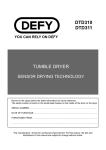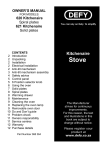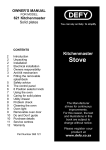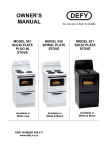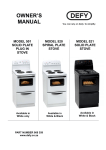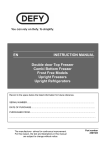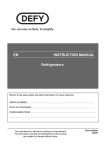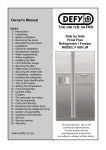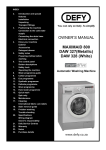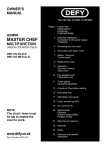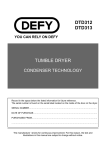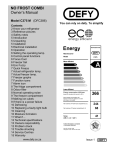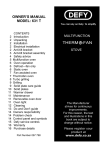Download Defy C130 Owner`s manual
Transcript
Contents 3. 4. 5. 6. 7. 7. 8. Safety warnings Safety warnings Do’s and don'ts Unpacking and Installation Electrical installation Operation Operating the freezer-Multi Mode 8. Setting the temperature 9. Using as a Refrigerator 9. Using as a Chiller 9. Using as a Freezer 9. Multimode characteristics 10. Deep freeze information 11. Defrosting 11. Maintenance & cleaning 12. Trouble shooting 13. Owners responsibility 13. Service 14. Service centres 15. Warranty 16. Model range, Features and benefits Owner’s Manual Electric Chest Freezers Figures represented in this instruction manual are schematic and may not correspond exactly with your freezer. If the parts are not included in the freezer you have purchased, they may be model specific and therefore only valid for some models. www.defy.co.za Part Number 13875 Page 1 Read this manual before initial installation and operation of the Chest Freezer! Dear customer, Your new Defy Chest Freezer was manufactured in a state of the art facility and has passed the strictest quality control procedures. Please read this manual carefully before using your Chest Freezer for the first time and then store it within easy reach for future reference. We trust you will enjoy years of trouble free use. The user manual: • This manual will provide you with information on how to safely operate and care for your Chest Freezer in order that you gain the maximum benefit from it. • Pay particular attention to any safety instructions. • Please read all additional documents supplied with your Chest Freezer. • Please note that this manual may be used for several similar but different models. Please check for relevance regarding your particular model. Explanation of symbols used in this manual: Important safety information. Warning for hazardous situations with regard to life and property. Caution; Warning for supply voltage. Caution; Warning for fire hazard. Read the instructions. Useful information. Important information or useful hints about usage. Note: This appliance is not intended for use by persons (including children) with reduced physical, sensory or mental capabilities, or lack of experience and knowledge, unless they have been given supervision or instruction concerning use of the appliance by a person responsible for their safety. Children should be supervised to ensure that they do not play with the appliance. Page 2 Safety Warnings • • • • • • • • • • • • • • • • • • • • • • • • • • To obtain the best possible performance and trouble free operation from your freezer it is very important to carefully read these instructions. This owners manual must be handed over to the new owner should ownership change. This freezer must only be used for its intended purpose i.e. the storing and freezing of edible foodstuff. Use only indoors and in closed areas. Consult with your authorised DEFY service centre for all questions and problems relating to the Chest Freezer. Only authorised agents are to carry out repairs. Vapour and vaporized cleaning materials should never be used in the cleaning and defrosting of your Chest Freezer. The vapour may come into contact with the electrical parts and cause a short circuit or electric shock. Never sit on, stand on or use your freezer lid as a step. Do not use electrical appliances inside the freezer. Do not drill, cut or modify the Chest Freezer. Injuries may result if the refrigerant circuit is damaged. Do not damage the refrigerant circuit. Keep ventilation openings, in the freezer enclosure or in the built-in structure, clear of obstruction. Repairs are to be carried out by authorised persons only. Repairs carried out by incompetent persons create a risk for the user. Unplug the freezer in case of failure or when cleaning, during routine maintenance or if it will not be used for an extended period. To unplug the Chest Freezer, remove the plug by pulling on the plug and not the cable! Do not use mechanical devices or other means to accelerate the defrosting process, other than those recommended by the manufacturer. Do not operate a damaged Chest Freezer. Consult with your nearest DEFY service centre should you have any concerns. The electrical safety of the Chest Freezer will only be guaranteed if the earth system of your home is compliant with national standards. Exposing the freezer to rain, snow, sun and wind is a dangerous electrical safety risk. Should the mains lead of the freezer become damaged or should it need replacing at any time, it must be replaced by a special purpose made mains lead which can only be obtained from a DEFY Authorised Service Agent. Never plug the Chest Freezer into the wall outlet during installation. Risk of death or serious injury may occur. Never connect your freezer to electricity saving systems: They may damage the freezer. Avoid any damage to the power cable when transporting the Chest Freezer. Bending the cable may cause a fire. Never place heavy objects on the power cable. Do not touch the plug with wet hands. Do not plug in the freezer if the wall outlet is loose. Do not spray water in or onto the freezer for safety purposes. Do not store or use flammable gas, benzene, petrol or volatile substances in or near the freezer. Never pour or spray water into the freezer and do not store liquids, pot plants or open containers on top of the freezer as these might spill causing electrical shorting. DO NOT connect your freezer to the electricity supply until all packing and transit protectors have been removed. These are put in place to protect the Chest Freezer during warehousing and transport, it is provided with spacers between the door and the cabinet (on the front and rear side). These spacers must be removed before putting the freezer into operation. Page 3 Safety Warnings Leave the freezer to stand for at least 12 hours before switching on to allow the compressor oil to settle. • If your Chest Freezer has a lock, keep it locked and store the key in a safe place and out of reach of children. • If you are discarding an old freezer with a lock or latch fitted to the door, disable the lock/latch, ensure that it is left in a safe condition to prevent the entrapment of young children. • See Installation Instructions for information on a suitable location. • On delivery, check to make sure that the product is not damaged and that all the parts and accessories are in perfect condition. • Ensure that the plug remains readily accessible. Do not use multiple adapter plugs or an extension cable. • Failure to observe these instructions may invalidate your right to free service during the warrantee period. • Ensure that there is sufficient spacing between the Chest Freezer and surrounding walls. • Unplug the Chest Freezer from the mains when you do a complete defrost on the Chest Freezer or when you clean the Chest Freezer. • It is not advisable to switch the Chest Freezer off if it is not going to be used for a few days only. • If the Chest Freezer is not going to be used for a longer period, proceed as follows to reduce any fire risk caused by a possible problem with the power cable: Unplug the Chest Freezer, empty the freezer, defrost and clean it (see defrosting, maintenance and cleaning) . Leave the lid open to avoid any unpleasant smells. • Do not store explosive substances such as aerosol cans with a flammable propellant in the Chest Freezer. • This Chest Freezer is intended to be used in household and similar applications such as: • Staff kitchen areas in shops, offices and other working environments; Farm houses and by clients in hotels, motels and other residential type environments; Bed and breakfast type environments; catering and similar non-retail applications. Never dispose of the Chest Freezer in a fire. Do not dispose of your Chest Freezer along with regular household waste. Contact your local authority for disposal information and facilities available. Page 4 Do’s and Don’ts Do’s Do – Defrost food from the freezer thoroughly in a fridge or in a microwave oven following defrosting and cooking instructions. Do – Ensure that the chest freezer lid is completely closed after each use. Do – Defrost frozen meat completely before cooking. Do – Close the lid gently. Do – Check contents of the freezer at regular intervals. Do – Clean and defrost your freezer regularly (See “Defrosting”). Do – Keep food for as short a time as possible and adhere to “Use by” and “Best before” dates. Do – Store commercially frozen food in accordance with the instructions given on the packets that you buy. Do – Choose high quality fresh food and ensure it is well cleaned before you freeze it. Do – Prepare fresh food for freezing in small portions to ensure rapid freezing. Do – Wrap all foods in aluminium foil or freezer quality plastic bags and make sure any air pockets are pressed out. Do – Wrap frozen food when you buy it and put it in to the freezer as soon as possible. Do – Store small items in the basket provided. Do – Remove ice cream from the freezer 10-20 minutes before serving. Do – Follow the defrosting procedures as described in the “Defrosting” section. Don’ts Don’t – Leave the lid open for long periods as this will make the freezer more costly to run and cause excessive ice formation. Don’t – Use pointed sharp edged objects such as knives, forks to remove excess ice. Don’t – Use electric appliances inside the freezer for defrosting. Don’t – Put hot food in the freezer. Let it cool down first. Don’t – Put liquid-filled bottles, fizzy drinks, jars, sealed cans or cans containing carbonated liquids into the freezer as they may burst. Don’t – Store flammable, explosive, poisonous or dangerous substances in the freezer. Your freezer has been designed for the storage of edible foodstuffs only. Don’t – Exceed the maximum freezing capacity when freezing fresh food. Don’t – Consume ice-cream and ice cubes direct from the freezer. The low temperature may cause ‘freezer burns’ on lips. Don’t – Try to keep frozen food which has thawed, it should be eaten within 24 hours or cooked and refrozen. Don’t – Remove items from the freezer with wet hands. Don’t – Shut the lid with force. You will damage the Chest Freezer. Don’t – Climb on the Chest Freezer . Don’t –Allow children to play or hide inside the Chest Freezer. Don’t – Use the Chest Freezer near heating appliances, cookers or other sources of heat and fire. Don’t – Leave food in the Chest Freezer if it is not working. Page 5 Unpacking • • Please ensure that packaging material is disposed of in a responsible manner. Plastic bags should be cut up to prevent children playing with them and accidentally suffocating. If the freezer is damaged in any way, do not use it. Report the damage to your dealer, who will take the necessary corrective action. Installation Caution: Never plug the Chest Freezer into the wall socket during installation. Risk of death or serious injury may occur. DO NOT connect your freezer to the electricity supply until all packing and transit protectors have been removed. Do not plug in the Chest Freezer if you notice a failure. Contact your nearest DEFY service centre for assistance. The Chest Freezer should be solidly positioned on the floor in a dry, well ventilated area away from heat sources such as stoves, geysers and direct sunlight and in such a way that air flow through the grill is not restricted. Placing it in a warm room, or near a heat source will increase the energy consumption and shorten the product life. This Chest Freezer was designed to operate at an ambient temperature between +10 degrees C and +32 degrees C. If the ambient temperature is below or above this range, the temperature inside the Chest Freezer may vary. Please observe the following minimun distances: 100 cm from coal or oil type cookers and 150 cm from gas and electric cookers. Ensure free circulation of air around the Chest Freezer by observing the correct distances. Assemble the supplied spacer limiters onto the condenser. (See diagram below). Assemble the supplied accessories. SPACER LIMITERS Fit the spacer limiters into the designated slots ‘A’ and turn the limiters 90 degrees into place. Note: SPACER LIMITER Page 6 Figures represented in this instruction manual are schematic and may not correspond exactly with your freezer. If the parts are not included in the freezer you have purchased, they may be model specific and therefore only valid for some models. Electrical Installation This Chest Freezer must be earthed and the manufacturer and the seller do not accept responsibility for any damage due to incorrect electrical connection. • • • • • • This Chest Freezer is designed for use on 220-240V~, 50 Hz. This makes it suitable for operation in all areas in South Africa. A moulded plug is fitted by the manufacturer, if the plug or power supply cord is damaged they must be replaced by the manufacturer, their service agent or a similarly qualified person in order to avoid a fire hazard. Should the mains lead of the freezer become damaged or should it need replacing at any time, it must be replaced by a special purpose made mains lead which can only be obtained from a DEFY Authorised Service Agent. No other appliance should be connected to the same terminal point. Before you insert the plug into the wall socket make sure that the voltage and the frequency shown on the rating label on the freezer corresponds to your electricity supply. The rating label is located on the rear outer side of the freezer. We recommend that the Chest Freezer be connected to the mains supply via a suitably switched and fused socket. The Chest Freezer must be positioned so that the plug is accessible. Operation Before operating, clean the inside of the freezer. (see “ Maintenance and Cleaning"). After the freezer has been cleaned, insert the plug of the Chest Freezer into the wall socket. Adjust the thermostat knob to an average position. Leave the freezer to work for about 6 hours without putting food inside it. Freezing of fresh food will be acheived after a minimum of 20 hours of operation (when there is uninterrupted power to the unit). Note: If you find that the lid of the chest freezer is difficult to open just after you have closed it, this is due to the pressure difference which will equalize and allow for the lid to be opened normally after a few minutes. Page 7 Operating the freezer-Multi Mode Select the operating mode (see setting the temperature as set out below). Plug the unit into a 15A earthed wall socket and switch on. Wait for at least six hours before loading the freezer with food. An on /off indicator light, on the cabinet front, glows when there is power to the unit. Setting the temperature The freezer is designed to operate in three ways. It can operate as a: 1. A refrigerator, 2. A chiller, 3. A freezer. • The temperature selection knob is located in the side ventilation grille. • Turn the knob to the desired sector on the dial. Refrigerator, Chiller or Freezer. The temperature in the cabinet may be adjusted by turning the knob slightly left or right in each function sector. Left for a higher and right for lower temperature. • Note: Figures represented in this instruction manual are schematic and may not correspond exactly with your freezer. If the parts are not included in the freezer you have purchased, they may be model specific and therefore only valid for some models. Page 8 Using as a Refrigerator At the refrigerator setting on the dial, the temperature in the cabinet will be above 0 degrees C. This temperature is ideal for storing perishable foods such as dairy products, fresh vegetables, and cold meats. Cold drinks can also be stored at this temperature. Using as a Chiller At the Chiller setting on the dial, the unit may be compared with a butcher’s cold storage facility. The temperature in the cabinet can range from 2 degrees C to -2 degrees C This temperature or ‘Partial Freeze’ is ideal for storing meat or fish for a short period. The advantage is that the food can be cooked without first defrosting or thawing it. Food stored at the Chiller setting will not release water and will keep its natural fibre. Sometimes it is undesirable to freeze a fine cut of meat as some of the flavour would be lost during freezing. At the Chiller setting, meat could be cooked as though it were fresh and portions could be removed without thawing, while the balance could be stored for another occasion. Using as a Freezer At the freezer setting on the dial, the temperature in the cabinet is set at a minimum of -18 degrees C. This temperature is ideal for storing frozen food for long periods of time. Deep Freeze packaging information Materials to be used for packaging must be tear-proof and resistant to cold, humidity, odour, oils and acids and they must also be airtight. They must be made from materials that are suitable for deep freeze usage. Materials necessary for packaging Cold resistant adhesive tape, Self adhesive labels, Rubber rings and a Pen. Maintaining the quality of food Food must be frozen as rapidly as possible when placed in a freezer to maintain the quality of the food. It is possible to keep the food for a long time period only at temperatures of -18 degrees C or lower. The quality of food in a freezer can be maintained for many months at temperatures of -18 degrees C or lower. Multi mode characteristics During the refrigerator or Chiller operation, there could be a build up of condensation water on the cabinet floor. This is normal and the water should be sponged up and removed whenever it becomes excessive. If the unit is used as a freezer, it will require periodic defrosting. The cabinet also requires defrosting before switching from freezer to refrigerator or Chiller operation. The defrosting procedure is described in this book on page 11. Page 9 Deep freeze information • • Pre-packed commercially frozen food should be stored in accordance with the frozen food manufacturer’s instructions for a (4 star) frozen food storage compartment. To ensure that the high quality achieved by the frozen food manufacturer and the food retailer is maintained, the following should be remembered: Put packages in the freezer as quickly as possible after purchase. Ensure that contents are labelled and dated. Do not exceed “Use By” or “Best Before” dates on the packaging. If there is a power failure do not open the freezer lid. Even if the power failure lasts up to the “Autonomy” time, frozen food will not be affected. In case the failure lasts longer, the food must be checked and when necessary, must be consumed immediately or must be frozen after being cooked. • • • • • • • • • • • • • • • Wrap all food before storage. Seal all foods, or place in airtight containers to prevent dehydration. Eliminate all the air pockets from packages and keep air out by firm sealing. When packaging in sheet material such as aluminium foil, parcel tightly and press out all air pockets. All folds should be sealed with deep-freeze sealing tape. Unwrapped food containing acids or salt may permanently stain the cabinet interior. When loading bulk into the freezer, load one quarter at a time and allow to freeze before loading the next quarter. Divide food into reasonable portions according to your requirements. Allow hot food to cool before putting it into the freezer. Freeze cooked food in small quantities. This ensures rapid freezing and maintains the quality of the food. Food that has defrosted must be consumed within 24 hours. Only cooked food can be refrozen. Do not re-freeze food that has defrosted. Do not exceed the expiry date shown on food packs. Do not take out frozen food with wet hands. Your hands could stick to the frozen food. Always use appropriate packaging material to avoid odour penetration or degradation of the food. Transport pre-frozen food from the supermarket in foil lined cooler bags and transfer to the home freezer as soon as possible. The storage baskets, where fitted, may be pulled out to facilitate loading. Place fresh food to be frozen near the side walls of the freezer to ensure fast freezing. Never exceed the maximum freezing capacity of the freezer. Do not freeze too large a quantity of food at any one time. The quality of the food is best preserved when it is frozen right through to the centre as quickly as possible. Take special care not to mix already frozen food and fresh food. Page 10 Defrosting 1. Defrost the freezer whenever the ice build up on the inside wall exceeds 5 mm in thickness. 2. Begin by removing the plug from the wall socket and then proceed as follows: 3. Open the lid and leave it open during defrosting. Remove the freezer baskets. 4. Remove the contents of the freezer, wrap them in newspaper and store in a cool place. 5. After the ice has melted and the water has run-off, wipe the freezer with a cloth or sponge. 6. Dry the cabinet with a soft cloth and replace the freezer contents. Close the lid, insert the power plug back into the wall socket and switch the freezer on. Note: Use a plastic scraper to remove excess ice on the frame and baskets. Never try to speed up defrosting by chipping at the ice with a sharp object. Never use metal objects, hairdryers, electrical heaters or any electrical appliances for defrosting. Maintenance and Cleaning • • • • • • • • • • • Always disconnect the plug from the mains socket before cleaning the Chest Freezer. Remember that turning the thermostat to “0” does not switch the power off. Clean the outside of the Chest Freezer using lukewarm water and a sponge. Clean the inside of the Chest Freezer when necessary by using a solution of one table spoon of Bicarbonate of Soda to two litres of warm water. Make sure that no water enters any electrical items. Dry with a soft cloth . Do not use pot scorer's, abrasive powders, soap, household cleaner, detergent or wax polish to clean the Chest Freezer. Spillages, especially citric and acidic juices, must be wiped up immediately as they could stain the Chest Freezer. Freezer baskets may be removed for cleaning purposes. The back of the Chest Freezer may be vacuumed or dusted using a soft bristle brush. If your Chest freezer is not going to be used for a long period of time, unplug the power cable, remove all food, clean it and leave the door ajar. Check the lid seal regularly to ensure it is clean and free from food particles. Safety key—Fitted to certain models only Safety Key Push & Turn Push & Turn INSERT KEY IN LOCK IN THIS POSITION THE KEY WILL REMAIN IN THE LOCK, BUT WILL NOT TURN. TO LOCK OR UNLOCK. PUSH THE KEY FULLY INTO THE LOCK, HOLD AND TURN. WARNING: If your freezer is fitted with a lock, always keep the key in a safe place where small children cannot reach it. Page 11 Trouble shooting Please review this list before calling a service centre. This list includes frequent complaints that do not arise from defective workmanship or material usage. Some of the features described here may not apply to your model. Symptom Check The freezer does not operate. • Make sure the freezer plug is securely plugged in. • Check for a blown fuse or tripped circuit breaker. • Test the wall socket for power using another appliance. • Inspect the electrical cord for damage. • Eliminate the use of an extension cord, if any is being used. Compressor is not running. • Your freezer is not plugged into the wall socket. Make sure that the plug is properly fitted into the wall socket. • Have the temperature adjustments been correctly made? • Power might be cut off. The freezer is running continuously or for a long time. • The ambient room temperature may be high. This is quite normal. • The freezer might have been plugged in recently or might have been loaded with food. Cooling down of the freezer completely may last for a couple of hours longer. • Large amounts of hot food might have been put in the freezer recently. Hot food causes longer running of the freezer until the food has cooled. • the freezer lid might have been opened frequently or left ajar for a long time. The warm air that has entered into the freezer causes the freezer to run for longer periods. Open the lid less frequently. • The freezer lid might have been left ajar. Check that the lid is properly closed. • The freezer is adjusted to a very low temperature. Adjust the freezer temperature to a warmer degree and wait until the temperature is achieved. • The lid seal of the freezer may be soiled, worn out, broken or not properly seated. Clean or replace the seal. A damaged/broken seal causes the freezer to run for a longer period of time in order to maintain the current temperature. There are noises coming from the freezer like liquid spilling or spraying. • Liquid and gas flow occur in accordance with the operating principles of your freezer. It is normal and not a fault. The lid is not closing. Incorrect packing of foods may prevent the lid from closing. Repack the foods that are obstructing the lid. If you have followed the instructions and still have a problem, contact the nearest Defy Service Centre. They will be able to advise you on any aspect of the product or send a qualified technician to repair it. Page 12 Owners responsibility Since the following are not factory faults they are the owners responsibility: • • • • • • Damage to the exterior finish. Breakage of components. Damage caused through improper use of the Chest Freezer. Damage caused by moving the Chest Freezer. Blocked defrost drain. The Company shall not be held liable for the loss of goods stored in the freezer should the Chest Freezer malfunction. Service Before calling a service technician to assist with a problem, please check: • • • • • Is the thermostat in the OFF position? The thermostat should be ON Is the power switched OFF? The power should be ON. Has a house fuse blown or a circuit tripped out? Repair or re-set as necessary. Is the 3-pin plug pushed firmly into the wall socket? Check another appliance such as a toaster or kettle in the same socket. Has the lid been left open for a long time? Close the lid and monitor performance. Remember that you may be charged for a service call even during the warranty period if the fault is caused by any of the above. Page 13 Defy Service Centres BLOEMFONTEIN JOHANNESBURG 160 Long Street, Hilton, Bloemfontein 9301. Tel. 051 400 3900 [email protected] Cnr. Mimetes & Kruger Sts. Denver ext.12 Johannesburg. 2094. Tel. 011 621 0200 or 011 621 0300 [email protected] CAPE TOWN POLOKWANE 5A Marconi Rd. Montague Gardens, 7441. Tel. 021 526 3000 [email protected] 87 Nelson Mandela Drive. Superbia 0699. Tel. 0152 92 1166 / 7 / 8 / 9. [email protected] DURBAN PORT ELIZABETH 35 Intersite Avenue, Umgeni Business Park, Durban 4051. Tel. 031 268 3300 [email protected] 112 Patterson Road, North End, Port Elizabeth 6001. Tel. 041 401 6400 [email protected] EAST LONDON PRETORIA 16 Bowls Rd. Arcadia, East London 5201. Tel. 043 743 7100 [email protected] Block A1 Old Mutual Industrial Park. Cnr. D.F.Malan Drive & Moot Str. Hermanstad. 0082. Tel. 012 377 8300 [email protected] OTHER AREAS ARE SERVICED BY OVER 200 AUTHORISED SERVICE AGENTS. PLEASE CONSULT THE NEAREST REGIONAL DEFY SERVICE CENTRE FOR DETAILS. Page 14 Warranty This certificate is issued by DEFY APPLIANCES LIMITED manufacturers of Defy and Ocean products, hereinafter the Company, to the original purchaser only, of the appliance described on the certificate and shall constitute the only warranty given in respect of this appliance. The Company warrants to the original purchaser that for a period of TWO YEARS from date of purchase the appliance is free from defect under normal domestic use, both in workmanship and material, subject to the following conditions. 1. Repair or replacement of any part of this appliance, found by the Company to be defective, shall be at the election of the Company. The Company reserves the right to effect such service through any of its Service Divisions or Authorised Service Dealers. The cost of such service shall be borne by the Company in full, provided that the appliance is located no further than 50 km from a Company Service Centre or an Authorised Service Dealer. Where the appliance is located beyond the 50 km radius, the purchaser shall be liable for the standard travelling charges, as determined by the Company. CARRY IN SERVICE Microwave ovens, Compact cookers and small appliances are repaired in our service centres and are not collected from the customers home. Faulty units should be delivered to the purchasing dealer or to the nearest Company Service Centre for warranty repairs. 2. Vitreous enamelware, fuses and lamps are specifically excluded from these warranties. It is an express condition of these warranties that the purchaser takes due care and attention in the use and maintenance of the appliance. Abuse, misuse in conflict with operating instructions, connection to incorrect voltages and subjection to commercial use shall release the Company from its obligations. 3. This warranty shall become void and cease to operate if the appliance is dismantled by, or any repairs to the appliance are effected by any persons not duly authorised by the Company, or if substitute parts not approved by the Company are used in the appliance, or if the serial number of the appliance is removed. 4. The Company shall not be responsible for damages resulting from fire, flood, civil disturbances or any Act of God. The Company shall not, in terms of these warranties be responsible nor held liable for any consequential loss or damage of any kind caused by or due to the failure or malfunction of the appliance. 5. The Company shall not be responsible for transportation or other costs other than those incurred within the provisions of Point 1 of this Certificate. 6. These warranties shall not apply to the appliance if it is purchased or used beyond the borders of the Republic of South Africa, Namibia, Botswana, Swaziland and Lesotho. 7. Where service is requested under warranty and no fault or defect can be found by the Company, all costs incurred will be for the purchaser's account. 8. This Certificate as well as your invoice will serve as proof of purchase. For the purpose of warranty, it will be essential to produce this Certificate and invoice. Failure to do so, will render the purchaser liable for service costs. KEEP THIS CERTIFICATE AND SALES INVOICE AS PROOF OF PURCHASE FOR WARRANTY PURPOSES. Page 15 Model range C130 C210 C270 C420 C320 C530 Features Variable control thermostat 4 star freezer Freezer baskets On/off indicator lamp Benefits Can be used as a refrigerator, chiller or freezer. Keeps food frozen longer. Convenient storage and removal of contents. Visual confirmation of power supply. (On specific models only) Rollers Easy moving to facilitate cleaning. (On specific models only) Spring loaded, counterbalanced lid Lid will remain open while accessing food. (On specific models only) Horizontal freezing coils More efficient freezing. Granite look vinyl covered lid Provides durable work-top. Thicker walls Provide superior insulation and saves energy. Lockable lid Provides security and safety. (On specific models only) Chromadek steel cabinet Durable and corrosion resistant. The Manufacturer strives for continuous improvements. For this reason, the text and illustrations in this book are subject to change without notice. Part Number 13875 Page 16
















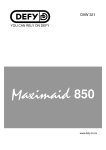
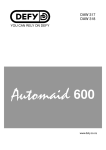
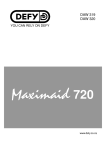
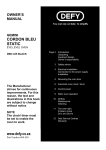
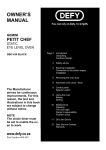
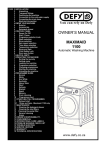

![8KG HEAT PUMP DRYER [Met DTD 315]](http://vs1.manualzilla.com/store/data/005851733_1-4b2b64d3b006b4e2563952fefa7cfd52-150x150.png)
